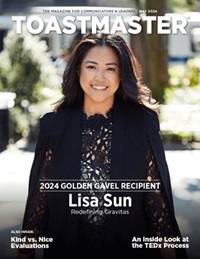
Jennifer Patterson was just a few months into her college career studying computer engineering when she realized the field wasn’t a good fit.
“When I went into computer engineering, I was very hopeful about what the experience was going to be like, but then I started taking courses in college, and I hated every class,” says Patterson, a member of BNY Mellon Toastmasters Club in Pittsburgh, Pennsylvania. “Either it was a disappointment, or I was really struggling because the work was so difficult. Sadly, engineering never ended up being what I was looking for.”
After a short engineering internship that confirmed her distaste for the field, Patterson transitioned into user experience (UX) design, creating digital products that provide enjoyable experiences for users. This specialty ended up being much more in line with her interests and skills.
“It was a nice mix of my external hobbies and what I was already learning in school,” she says. “I found some mentors online and started networking with people. Then I took it by the reins throughout the rest of college, doing well enough that I could pass my courses while focusing on my passion for this new field.”
Patterson is just one of many people who have successfully changed career paths. In recent years, making some type of switch has become a growing trend. According to the University of Queensland in Brisbane, Australia, the average person will have three to seven different careers before they retire—and younger workers are more likely to undergo five or more career changes.
Why Switch Careers?
The reasons for changing careers are varied, and they differ among age groups. Some people may want fresh challenges, more pay, better work-life balance, or even a shorter commute. Others may feel burnt out in a career field they’ve been in for decades. For some workers, changing careers may be the involuntary result of layoffs or downsizing. For others, a transition may be spurred by a desire to spend more time at home.
“Priorities change over time,” says Patterson, who now works as a senior associate UX/UI designer. “Sometimes you might care more about your career; other times maybe you care more about family. Priorities may change, your interests may change, and that’s totally okay. You have to follow what your heart is feeling.
“You also have to put in the work, though. Some people think it’s a magic thing or you can do it quickly. But it does take time and effort to be able to make a transition.”
Putting in the Work
The effort to transition into a new career often begins by taking a hard look at your current position, says career coach Jennifer Blanck, DTM. She suggests not only looking at the things you don’t like that are pushing you toward a new field, but also recognizing the things you do like in your job that can inform your next move.
“When people are ready for a change, they usually can identify the negative things in their current situation,” says Blanck, a member of 5-Star Toastmasters Club in Arlington, Virginia, and AAMC Toastmasters in Washington, D.C. “What I advise people to do is think about the positives. What would you like to keep? Is anything working? Are there certain aspects of your position that you love? You might know what you don’t want, but it’s also important to know what you do want. The first step is to assess yourself and be really honest.”
Although making a career transition may seem daunting, with some effort and careful thought it can be not only realistic, but also very fulfilling.
Some people know which field they want to transition into, Blanck says. Others may need to engage in a little introspection to find out where their future may lie.
“What are you reading about? Where do you spend your time? What do you get energized about when you’re talking about it?” she asks. “Once you’ve identified a field, go talk to people in those jobs, in those industries, at those organizations, and learn more about what it means to work there and what it takes to get there.”
Networking, the Toastmasters Way
Networking is a good way to learn more about different careers and industries you are interested in. This is likely to come more easily to those with a Toastmasters background, Blanck says—people who are used to having conversations with others, whose Table Topics® experience makes them experts at talking off the cuff. Toastmasters may also already have access to people in fields in which they are interested in simply because they are part of the same club.
“Table Topics are fantastic opportunities to practice for interviews because you never know what question you’re going to get,” says Blanck, adding that everything in Toastmasters is great preparation for job interviews. “You want to give a concise answer—opening, body, and closing. And being involved at meetings helps keep you active and interacting with people on a professional level.”
Of course, along with networking comes research. Go to LinkedIn and read the job descriptions of different positions. Find profiles of people who are successful in those fields and figure out what makes them tick.
“It’s important to take the time to do the research,” says Amy Krymkowski, a career coach who specializes in transitions, and a member of Cream City Communicators in Milwaukee, Wisconsin. “When you’re exploring industries, it helps to home in on three to five companies as targets. Look at their position descriptions and learn more about the companies you’re interested in.”
The Next Step
You know it’s time to make a change, and you’ve identified the field you want to transition into—so what’s the next step? There are several things that prospective career-changers should do as they begin the process, Krymkowski says, starting with making a list of things that are important to them.
“Often, when people begin looking at opportunities, they want to make a decision based on what the opportunity affords them, instead of starting with themselves first,” she says. “What are the things that are important to you from a job standpoint? The fit of the job, the work itself, the responsibilities—what’s going to be important to your career? What are your goals? Rather than getting attracted to all the bells and whistles of some great opportunity, ask yourself if it lines up with what you’re looking for.”
From there, experts say, it’s important to make a plan and stick to it. Will you need additional training or education? If so, where can you obtain it, and how much will it cost? Outside of Toastmasters, look to other sources for referrals and networking—family and friends, professional associations, the alumni association at your alma mater.
“When I made my first career transition, I said to myself, ‘I will do one thing a day to move myself forward,’” Blanck says. “That could have been writing a draft cover letter, reaching out to someone for an informational interview, or searching through job announcements. You’re treating it in a very structured way, and that keeps you on track.”
Although making a career transition may seem daunting, with some effort and careful thought it can be not only realistic, but also very fulfilling.
“Changing careers is a very personal thing,” Patterson says. “You have to think about what your strengths are, but also think about what you’re interested in. It’s important to find that balance or the bridge between where you are now and where you want to go. That’s the hardest part, but it’s very doable. Once you have that connection, it makes it so much easier. You don’t feel like you’re starting from scratch, because there are always transferable skills from one career to the next.”
Are you ready to make a career change? Once you begin a new job, start putting your Pathways skills into motion. Hear how the Pathways learning experience helped other Toastmasters reach a new level of leadership and communication in their workplace.
Greg Glasgow is a Denver-based author and freelance writer and a frequent contributor to the Toastmaster. His debut nonfiction book, Disneyland on the Mountain: Walt, the Environmentalists, and the Ski Resort That Never Was, was published in September 2023.
Related Articles

Professional Development
Advance Your Career Through Self-Leadership

Professional Development
Next-Step Networking

Personal Growth


 Previous
Previous

 Previous Article
Previous Article